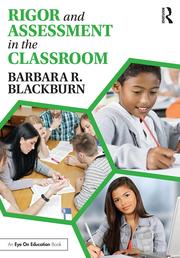5 Cool Ways for Students to Show What They Know
 By Barbara R. Blackburn
By Barbara R. Blackburn
Teachers are always looking for new ideas of how to help students demonstrate their understanding of a concept. After all, students become tired of always writing a paper. Let’s look at 5 creative ways that students can “show you what they know.”
 Newspapers and Websites
Newspapers and Websites
Chris Triolo encouraged his students to develop an understanding of science concepts through the creation of a newspaper. As he explains in the assignment:
You are the editor of Planet Daily News (or some newspaper of your choice). Your task is to design the front page of today’s newspaper. As with a newspaper, the front page should be divided into sections. You should have each of the eight science concepts we have learned in one or more of the sections. You must receive a score of 8–10 in order to have your article featured on the cover page. Be sure to follow the editor’s suggestions.
This could easily be adapted to create a website, which would encourage even more engagement from today’s tech-savvy learners.
Blogs and Wikis
Blogs, short (less than 350-word) entries, allow students to create a series of extended responses on a particular topic. For example, after students read a story or novel, they can write their response to the text. Many teachers use wikis or Google’s suite of tools to allow for students to write back and forth.
A key aspect of blogs is the written response by others, which requires the blog author to expand on the original response. Dave Craig used a blog with his fifth graders for reader response. After their initial entry about their book, other students responded with additional questions. The back-and-forth necessitates that the original author write at higher levels. As you begin, you may want to assign students particular blogs where they can respond with questions for the author.
Video Reporting
One of my son’s favorite activities is recording his friends skateboarding and editing the clips. He used these techniques in one of his math classes to analyze the math skills used in skateboarding. Given a choice of assignments, he would rather create a video than write a paper.
Students can create a video report on a wide range of topics in almost any class. Simply start with a topic, ask students to choose a perspective, and start filming. I’ve seen this used for students to create character profiles, job descriptions, and mini talk shows.
It’s an engaging, motivating activity. However, as with all activities, provide structure and guidelines to ensure students move beyond a basic assignment to one that requires higher levels of thinking.
Put Yourself in Someone Else’s Shoes
Another way to demonstrate understanding is to “Put Yourself in Someone Else’s Shoes.” Rather than simply researching a historical figure, character, or job role and writing a paper on the topic, ask students to truly step into the person’s shoes.
Students can create a fake Facebook wall or blog for the person, requiring them to move beyond basic information to reflect the person’s thoughts, actions, life events, and feelings. I overheard one student say, “Making a Facebook wall for Martin Luther King, Jr. was a lot harder than I thought it would be. I kept having to go back and get more information.”
Bio Poems
Angie Wiggins uses poetry in her social studies classroom. When she teaches a unit about ancient Egypt, students read a myth about Osiris and Isis. After reading the myth, they write a bio poem about one of the Egyptian deities. The bio poem requires that students explain the feelings, fears, and desires of the god the student chose. After writing the poem, the students translate it into hieroglyphics.
Sample Student Bio Poem
You can plan now to sprinkle these activities through the autumn months. Please let me know what works for you!
_________________

A nationally recognized expert in the areas of rigor and motivation, she collaborates with schools and districts for professional development. Barbara can be reached through her website or her blog. Follow her on Twitter @BarbBlackburn.

 Newspapers and Websites
Newspapers and Websites



































